Fisheries production in Province of Cebu decreased annually by 42.11% from 2022 to 2023
In 2023, the total volume of fisheries production in the Province of Cebu was registered at 25,987.53 metric tons. It diminished by 42.11% from the 44,890.35 metric tons output in 2022. Decrease in production was noted from Marine Municipal Fisheries and Aquaculture while Commercial Fisheries and Inland Municipal Fisheries reported increments in production. (Figure 1)
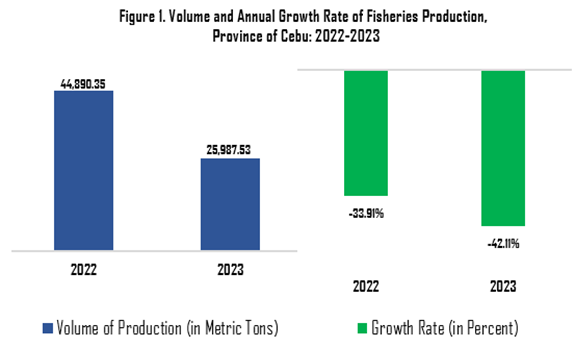
Source: Philippine Statistics Authority, Quarterly Commercial Fisheries Survey (QCFS), Quarterly Municipal Fisheries Survey (QMFS), Quarterly Inland Fisheries Survey (QIFS), and Quarterly Aquaculture Survey (QAqS)
The Commercial Fisheries production at 7,029.34 metric tons posted an increase of 11.79% from the previous year’s output of 6,287. 76 metric tons. The subsector comprised 27.1% of the total fisheries production. (Figure 2)
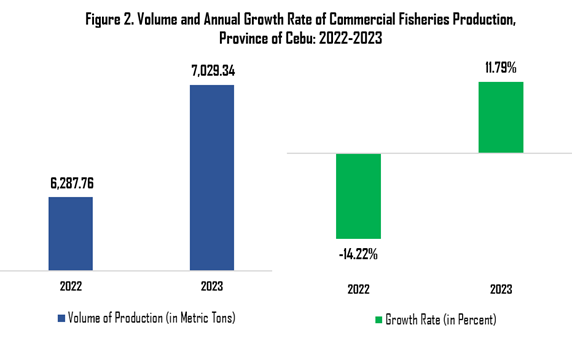
Source: Philippine Statistics Authority, Quarterly Commercial Fisheries Survey (QCFS)
The Marine Municipal Fisheries output was down to 48.78% from 26,032.61 metric tons in 2022 to 13,332.66 metric tons in 2023. This subsector had the highest share in the total fisheries production at 51.30%. (Figure 3)
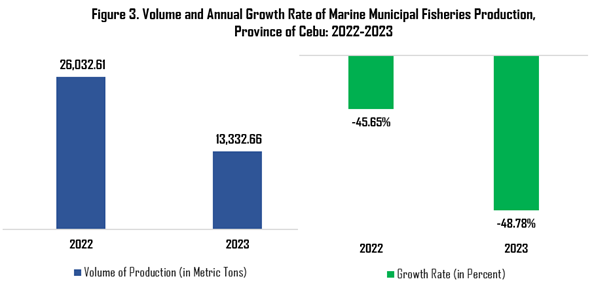
Source: Philippine Statistics Authority, Quarterly Municipal Fisheries Survey (QMFS)
In 2023, Inland Municipal Fisheries Production was recorded at 11.47 metric tons. The volume increased by 11.79% from 10.26 metric tons in the previous year. The subsector contributed 0.04% to the total fisheries production in 2023. (Figure 4)
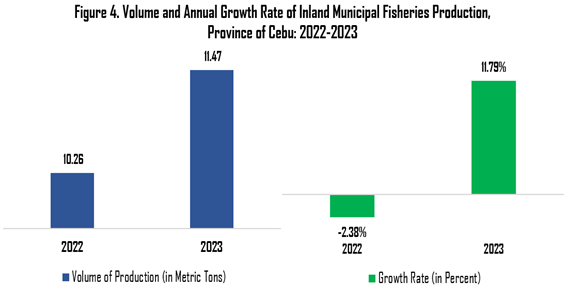
Source: Philippine Statistics Authority, Quarterly Inland Fisheries Survey (QIFS)
Aquaculture production was registered at 5,614.07 metric tons in 2023 from 12,559.72 metric tons in 2022. This subsector dropped by 55.30% with the highest decline observed among the other subsectors. Aquaculture production constituted the share of 21.60% to the total fisheries production in 2023. (Figure 5)
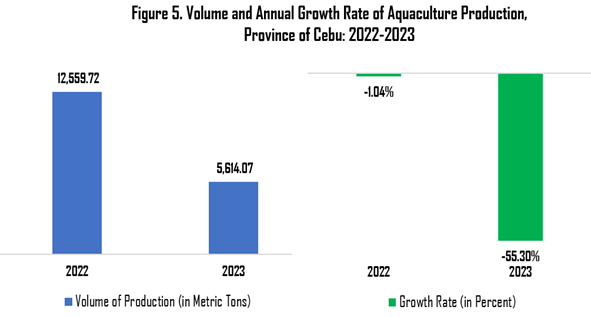
Source: Philippine Statistics Authority, Quarterly Aquaculture Survey (QAqS)
Table A. Top Five Species in Commercial Fisheries Production in
Province of Cebu, 2023
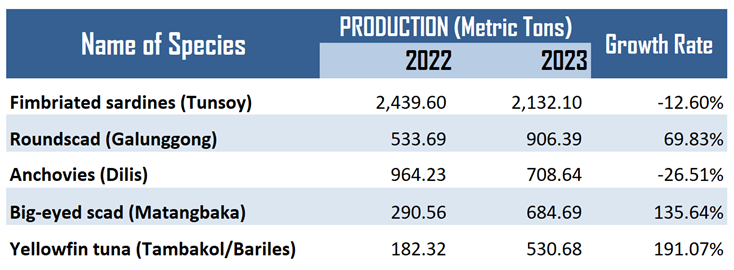
In 2023, the top five species in Commercial Fisheries Production with the highest volume among the other species were: Fimbriated sardines (Tunsoy), Roundscad (Galunggong), Anchovies (Dilis), Big-eyed scad (Matangbaka), and Yellowfin tuna (Tambakol/Bariles).
Fimbriated sardines recorded the highest production with 2,132.10 metric tons from 2,439.60 metric tons in 2022, despite a decline of 12.60%. This was followed by Roundscad, which posted an increase of 69.83% at 906.39 metric tons from 533.69 metric tons. Anchovies ranked as the third highest production in Commercial Fisheries at 708.64 metric tons but also showed a significant decrease of 26.51% compared to its 2022 production of 964.23 metric tons. (Table A)
Big-eyed scad production showed a substantial increase of 135.64% at 684.69 metric tons from 290.56 metric tons. Similarly, Yellowfin tuna had a remarkable increase of 191.07% at 530.68 metric tons in 2023 from 182.32 metric tons in the previous year. (Table A)
Table B. Top Five Species in Marine Municipal Fisheries Production in Province of Cebu, 2023

Source: Philippine Statistics Authority, Quarterly Municipal Fisheries Survey (QMFS)
The five species with the highest production volumes in Marine Municipal Fisheries compared to the other species were: Big-eyed scad (Matangbaka), Anchovies (Dilis), Fimbriated sardines (Tunsoy), Squid (Pusit), and Siganid (Samaral)
In 2023, Big-eyed scad recorded as the highest number of productions with 1,697.99 metric tons, which also showed a positive growth of 14.70% compared to last year’s production of 1,464.70 metric tons. This was followed by Anchovies, which posted a negative growth of 26.17%, from 1,485.25 metric tons in 2022 to 1,096.58 metric tons in 2023. Fimbriated sardines noted as the third species with the highest production by 1,072.96 metric tons but also showed a negative growth of 78.96% compared to its production of 5,100.17 metric tons last year. (Table B)
Furthermore, Squid recorded at 745.15 metric tons in 2023 from 436.72 metric tons in the previous year, showed a 70.62% increase, and Siganid registered at 550.89 metric tons from 1,520.61 metric tons with a decrease of 63.77%. (Table B)
Table C. Aquaculture Fisheries Production by Aquafarm in
Province of Cebu, 2023

Source: Philippine Statistics Authority, Quarterly Aquaculture Survey (QAqS)
In the Aquaculture sector, brackishwater cage and marine pen recorded a positive production growth compared to last year. In 2023, brackishwater cage production increased by 609.24% metric tons from 4.98 metric tons to 35.32 metric tons. Likewise, marine pen production posted an increase of 1,003.83% from 2.09 metric tons to 23.07 metric tons. (Table C)
On the contrary, negative growth rates in the production were posted in brackishwater fishpond by 0.77% from 1,944.48 metric tons to 1,929.59 metric tons, marine cage by 46.76% from 255.15 metric tons to 135.83 metric tons, and seaweed by 66.36% from 10,335.64 metric tons to 3,477.20 metric tons in 2023. (Table C)
TECHNICAL NOTES
Fisheries – all activities relating to the act or business of fishing, culturing, preserving, processing, marketing, developing, conserving and managing aquatic resources and the fishery areas including the privilege to fish or take aquatic resources thereof R.A. 8550.
Quarterly Fisheries Survey (QFS) – The fisheries sector is composed of three (3) subsectors, namely; commercial, municipal fisheries and aquaculture. There are four (4) quarterly surveys that generate volume and value of production by species at the national, regional and provincial level.
Commercial Fisheries – fishing operations in marine waters beyond 15 kilometers from the shoreline by fishing boats with more than three (3) gross tons. The Quarterly Commercial Fisheries Survey (QCFS) serves as the activity that gathers information on volume and price of species unloaded in the commercial landing center.
Municipal Fisheries – covers fishing operations in marine waters within 15 kilometers from the shoreline by fishing boats with three (3) gross tons or less. The Quarterly Municipal Fisheries Survey (QMFS) serves as the activity that gathers information on volume and price of species unloaded in the municipal landing center.
Marine Fisheries - refer to the industry devoted to the catching, processing, or selling of fish, shellfish, or other aquatic animals. Fish are caught in seawater or saltwater using synthetic fiber nets, mechanized fishing, etc. Marine fisheries have grown in size and sophistication in the last 50 years, and fish are caught in nets or on lines, sorted on board a fishing vessel, and then brought back to shore. Popular marine fish varieties include Mackerel, Tuna, Sardines, and Bombay duck.
Inland Fisheries – covers fishing operations performed in inland bodies of water using fishing vessels of three (3) gross tons or less, or fishing not requiring the use of fishing vessels. The Quarterly Inland Fisheries Survey (QIFS) serves as the activity that gathers information on volume and price of species caught by inland fishing households.
Aquaculture – involves propagation and culturing of fish and other fishery species in farming facility such as fishpond, fish pen and fish cage. It also includes oyster, mussel and seaweed culture. The Quarterly Aquaculture Survey (QAqS) serves as the activity that gathers information on volume and price of species harvested in the aquafarms.
Approved by:
(SGD)
MELCHOR B. BAUTISTA
Chief Statistical Specialist
FRES/MJDG

